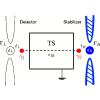当前位置:
X-MOL 学术
›
Phys. Rev. B
›
论文详情
Our official English website, www.x-mol.net, welcomes your feedback! (Note: you will need to create a separate account there.)
Stabilization of a Majorana zero mode through quantum frustration
Physical Review B ( IF 3.7 ) Pub Date : 2020-07-01 , DOI: 10.1103/physrevb.102.035103 Gu Zhang , Harold U. Baranger
Physical Review B ( IF 3.7 ) Pub Date : 2020-07-01 , DOI: 10.1103/physrevb.102.035103 Gu Zhang , Harold U. Baranger

|
We analyze a system in which a topological Majorana zero mode (tMZM) combines with a Majorana produced by quantum frustration (fMZM) to produce a novel ground state. The system that we study combines two parts, a grounded topological superconducting wire that hosts two tMZMs at its ends and an on-resonant quantum dot connected to two dissipative leads. The quantum dot with dissipative leads creates an effective two-channel Kondo (2CK) state in which quantum frustration yields an isolated fMZM at the dot. We find that coupling the dot to one end of the topological wire stabilizes the tMZM at the other end. Three routes are used to obtain these results: (i) calculation of the conductance through an auxiliary detector quantum dot, (ii) renormalization group (RG) arguments and the theorem, and (iii) a fully nonequilibrium calculation of the curve and shot noise through the detector dot. In addition to providing a route to achieving an unpaired Majorana zero mode, this scheme provides a clear signature of the presence of the 2CK frustration-induced Majorana.
中文翻译:

通过量子挫折稳定马约拉纳零模
我们分析了一种系统,其中拓扑马约拉纳零模(tMZM)与量子挫折(fMZM)产生的马约拉纳结合以产生新的基态。我们研究的系统由两部分组成:接地的拓扑超导线,该导线的两端托管两个tMZM,一个谐振的量子点连接到两个耗散引线。具有耗散引线的量子点可创建有效的两通道近藤(2CK)状态,其中量子挫折会在该点处产生一个孤立的fMZM。我们发现将点耦合到拓扑线的一端会稳定另一端的tMZM。可使用三种途径获得这些结果:(i)通过辅助探测器量子点计算电导,(ii)重整化组(RG)自变量和 定理,以及(iii)完全不平衡计算 曲线和散粒噪声 通过检测器点。除了提供实现未配对马略拉零模式的途径之外,该方案还清楚地表明了2CK挫折感诱发的马略拉。
更新日期:2020-07-01
中文翻译:

通过量子挫折稳定马约拉纳零模
我们分析了一种系统,其中拓扑马约拉纳零模(tMZM)与量子挫折(fMZM)产生的马约拉纳结合以产生新的基态。我们研究的系统由两部分组成:接地的拓扑超导线,该导线的两端托管两个tMZM,一个谐振的量子点连接到两个耗散引线。具有耗散引线的量子点可创建有效的两通道近藤(2CK)状态,其中量子挫折会在该点处产生一个孤立的fMZM。我们发现将点耦合到拓扑线的一端会稳定另一端的tMZM。可使用三种途径获得这些结果:(i)通过辅助探测器量子点计算电导,(ii)重整化组(RG)自变量和 定理,以及(iii)完全不平衡计算 曲线和散粒噪声 通过检测器点。除了提供实现未配对马略拉零模式的途径之外,该方案还清楚地表明了2CK挫折感诱发的马略拉。



























 京公网安备 11010802027423号
京公网安备 11010802027423号